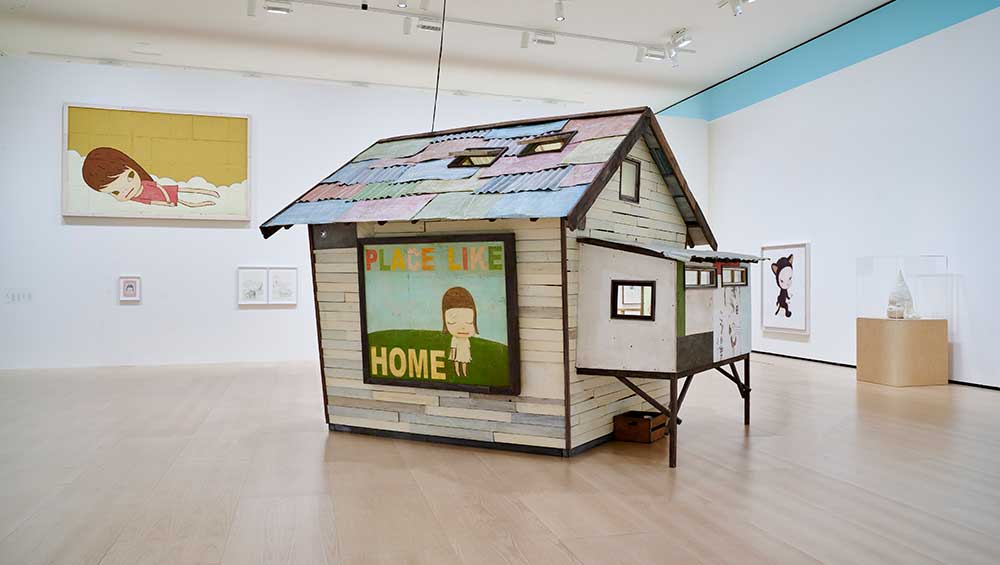
Yoshitomo Nara. My Drawing Room 2008, Bedroom Included, 2008. Installation view, Guggenheim Museum Bilbao, 28 June – 3 November 2024. Image courtesy Guggenheim Museum Bilbao.
Guggenheim Museum Bilbao
28 June – 3 November 2024
by TOM DENMAN
In the winter of 2016, an 11-year-old boy set up a desk on the New York subway and offered emotional advice to adult passersby for $2. I’m not sure why the story is trending again on Instagram, but I came across it recently, after seeing Yoshitomo Nara’s latest retrospective at Guggenheim Bilbao. The story immediately reminded me of Nara’s depictions of children, which also mirror something of ourselves back to us. But whereas this astonishingly wise boy was seemingly unscathed by his exposure to adult trauma, the children in Nara’s work are tortured, some wearing bandages to caricature the knocks and bumps of childhood – and also, one feels, to signify deeper wounds, wounds the bandages protect by way of concealment. Nara’s opaquely psychological images of otherworldly children pulsate with a complexity of emotional pain that exceeds our idea of innocence, as if the kids carry the imprint of the adult world’s woes. I wonder if we don’t look at them as we looked at that boy on the subway – with the hope that the genius of childhood might reveal who we are.
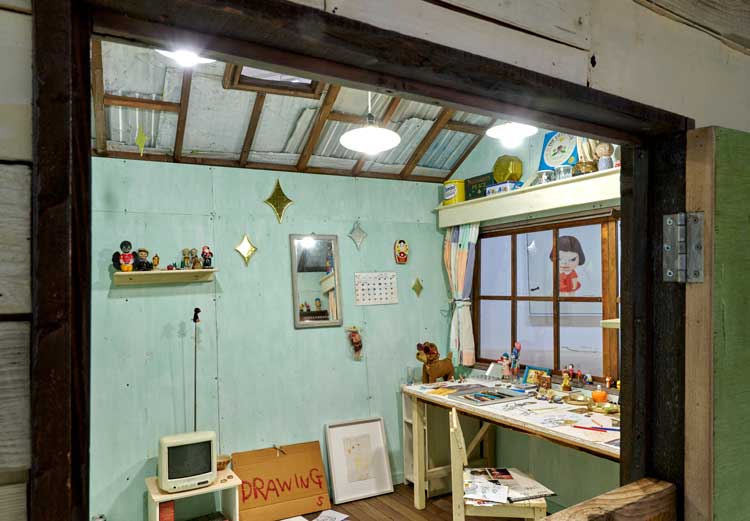
Yoshitomo Nara. My Drawing Room 2008, Bedroom Included, 2008. Installation view, Guggenheim Museum Bilbao, 28 June – 3 November 2024. Image courtesy Guggenheim Museum Bilbao.
The exhibition, spanning Nara’s career – from his years of rigorous study at Aichi University of the Arts and Kunstakademie Düsseldorf to international superstardom – and installed by the artist himself, seeks to be a portal, immersing us in the non-linear world of his creative imagination. This is suited to his work’s psychological depth, born, we are told, out of his isolation growing up in the sleepy prefecture of Hirosaki in northern Honshu, home alone, with both his parents at work, and later as a student in Düsseldorf, unable to speak German. The opening room includes My Drawing Room 2008, Bedroom Included (2008), one of Nara’s miniature homes, metaphorically suggestive of psychic interiority, to which we are given partial, visual access. Inside it are beer bottles, figurines, a drawing desk, drawings scattered on the floor and up the walls, and punk rock blaring. Outside is a hand-painted billboard with a child resembling a girl, a plaster on her forehead, her eyes closed, the words “PLACE LIKE HOME” in the sky. She could be Dorothy tapping her heels, or any child imagining a place of familial warmth.
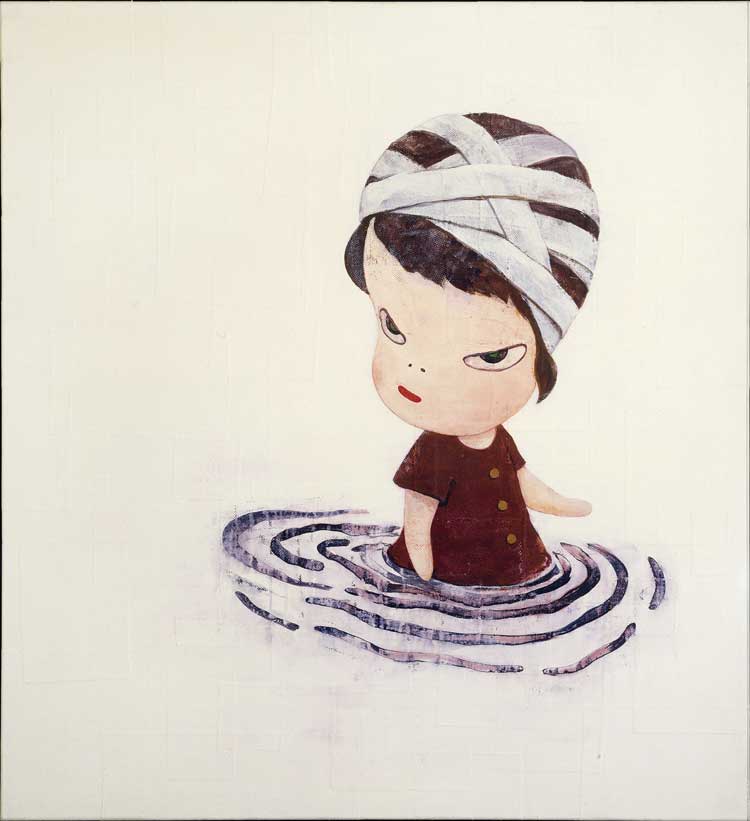
Yoshitomo Nara. In the Deepest Puddle II, 1995. Acrylic on cotton mounted on canvas, 120 x 110 cm. Takahashi Ryutaro Collection. © Yoshitomo Nara, courtesy Yoshitomo Nara Foundation.
On the wall adjacent to the hut are some of Nara’s most famous stroppy-faced kids of the 1990s, when he developed his pared-down aesthetic, breaking away from the rougher, busier works of his youth – such as, for example, the multi-figural dreamscape of People on the Cloud (1989). Now, the agitation trembles beneath the surface: In the Deepest Puddle II (1995) presents a child with a bandaged head, submerged up to their hips, their facial expression daring us, it seems, to make a comment; the child in Missing in Action (1999) is livid, cheeks flushed, eyes bloodshot, a fist clenched. At first, one may slight the anger as bratty. But the longer I look, precisely this state of being unheard, unattended to, comes to the fore as Nara’s true subject, and we have all been that unlistened-to child; even if we think we haven’t, in all likelihood we have neglected the child within us. Nara’s sophistication of line and colour defies his work’s seeming simplicity, just as a child’s intelligence – or that clarity of vision that a child might prove to have (often with a seemingly offhand, heartbreaking remark), and that adults might feel they have lost – defies any notion of immaturity.
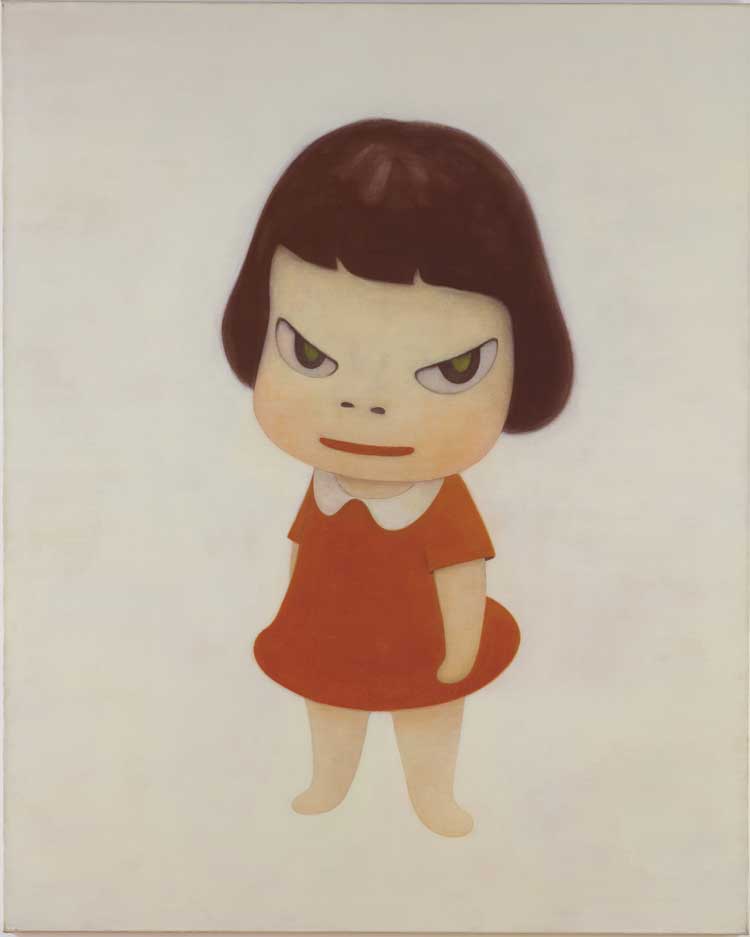
Yoshitomo Nara. Missing in Action, 1999. Acrylic on canvas, 180 x 145 cm. Courtesy of Sally and Ralph Tawil. © Yoshitomo Nara, courtesy Yoshitomo Nara Foundation.
Nara’s attentiveness enlists our own, often with astonishing economy. Little Thinker (2021) is a small drawing of a button-nosed, bodiless head within a yellow background, the word “THINKER” scrawled beneath it. Nara’s attentive layering of colour – the orangey pinks breaking through the bleached creams of the cheeks, the unexpected harmony this makes with the dart of the mouth, tight enough to suggest concentration – pays painterly respect to the child’s interiority. This invites slow, contemplative viewing that sets Nara’s work apart from the more instantaneous, narrative-based imagery of manga, or the poppy Superflat aesthetic invented by Takashi Murakami – with which Nara has been misleadingly associated. By the same token, it may be argued that Nara’s practice resists easy meme-ification.
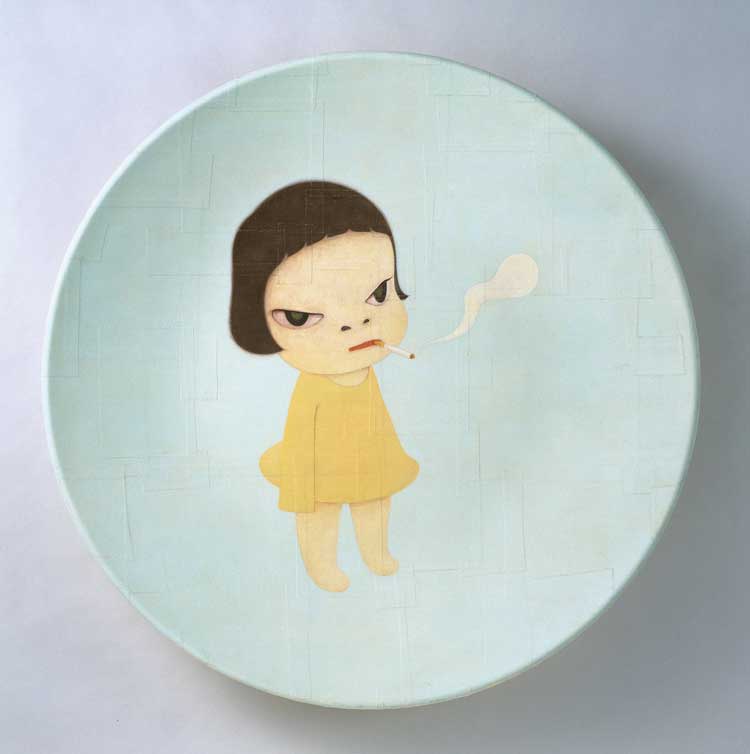
Yoshitomo Nara. Too Young to Die, 2001. Acrylic on cotton mounted on fibre-reinforced plastic (FPR), 180 cm diameter. Courtesy of the Rubell Museum, Miami and Washington, D.C. © Yoshitomo Nara, courtesy Yoshitomo Nara Foundation.
My love of Nara’s subjects often precedes my love of the works – I speak about loving her, him or them, not it. Subject and work are inseparable, which is neither an optical illusion nor an effect of portraiture (in which we may be inclined to perceive the work of art as the sitter), for the works do not refer to any tangible reality outside of them. The referent is within us, the “inner child”, an unpicturable subpersonality invoked by Nara’s subjects and his ability to make us feel we are experiencing colour and line for the first time. Maybe this is why the concavity of some of his surfaces – including those of Too Young to Die (2001), Slight Fever (2001) and Shallow Puddles 2006 (2006) – seems intentionally to allude to, if not to activate, the viewer’s introspection. Despite being “unrealistic”, the children appeal to a real, deep-rooted playfulness; their opacity allows room for us to invent them in personal and subjective ways, sometimes to cathartic effect (as attested by the tears of the woman I attend the show with). This psychic indeterminacy reflects Nara’s comments – made in an interview with Index Magazine in 2001 – that his figures are “neither male nor female”, and that he might be channelling a sister who died before he was born. His works excite a child’s voice within, calling from beneath the obfuscation of ideology.
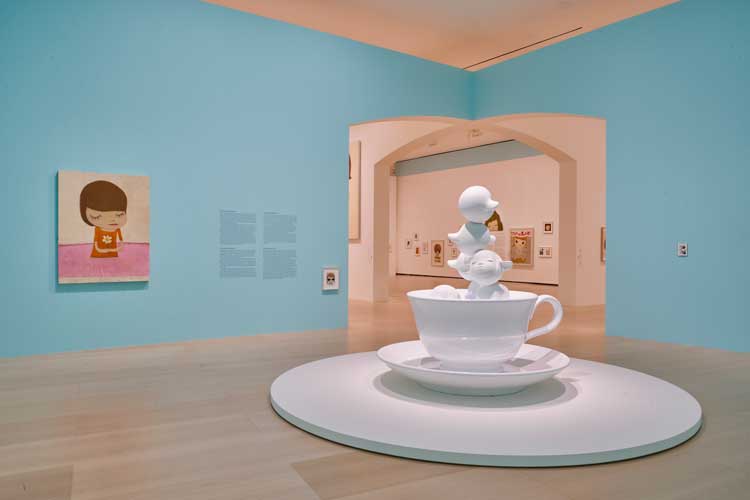
Yoshitomo Nara. Installation view, Guggenheim Museum Bilbao, 28 June – 3 November 2024. Image courtesy Guggenheim Museum Bilbao.
Sometimes the child points to adult actions beyond the work. In his paintings on found, nailed-together planks – materials affording a tenor of street protest – Stop the Bombs and No War (both 2019), the feeling is that we have failed the child standing before us. Nara’s works are funny, by way of being cute, but the funniness is a mask, and the cuteness softens us only to allow the harshness of reality in. In Dead Flower Remastered 2020 (2020), a mad-eyed child with blood dripping from its mouth, brandishes a saw, the words “Fuck You” on the back of its tunic. The child has severed – killed – a flower. Where in all my childhood drawings I put the sun, is a lightbulb. If children are supposed to be uncorrupted, or “natural”, this is at once an hilarious and horrific picture of innocence prematurely sabotaged. The sentiment is all but explicit in Too Young to Die, in which a browbeaten, jaded child puffs on a cigarette. Although there is something atemporal about Nara’s children – if we are open to the idea that they exist within us, no matter our age – childhood nevertheless stands for futurity. Our actions are their inheritance.
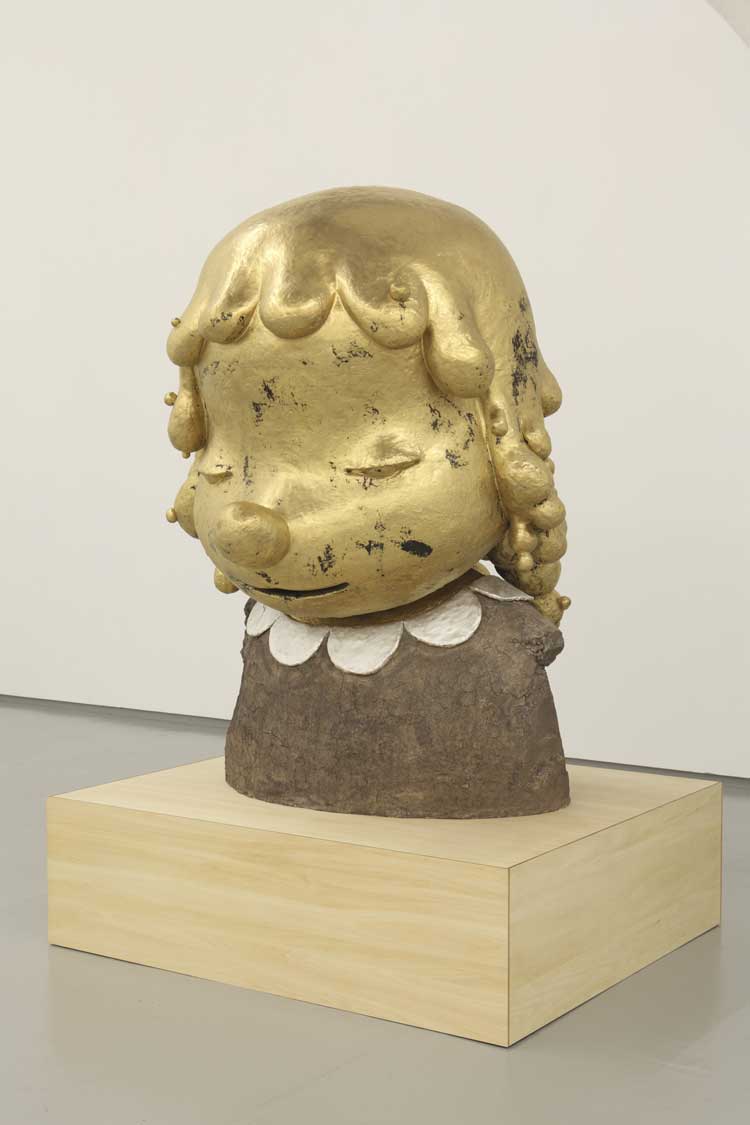
Yoshitomo Nara. Miss Forest, 2010. Ceramic decorated with platinum, gold, and silver liquid, 144 x 102 x 100 cm. Leeum Museum of Art, Korea. © Yoshitomo Nara, courtesy Yoshitomo Nara Foundation.
At times, Nara’s children have an oracular presence. Some of his later works, especially those postdating the Fukushima nuclear accident of 2011 – a turning point for the artist – zoom in on the faces, expanding them to a monumental scale. These paintings have the quasi-religious quality of his sculptures, such as Miss Forest (2010), whose sad face has had gold poured on it, probably against her will; or the mystical Little Thinker in Silence and Little Thinker in the Garden (both 2016), heads we may wish to be our guides. The churlish acting out of his earlier works has dissipated, and we are immersed in unmasked emotion, no less complex for being raw. In Nara’s large canvas Midnight Tears (2023), the face looking out at us, tears coagulating, throbs with sadness. The work is hung high, inviting an upturned, supplicating gaze. We look at the child for answers. The child is resolutely silent, as if to say: But it’s obvious. Can’t you see …